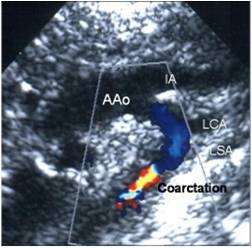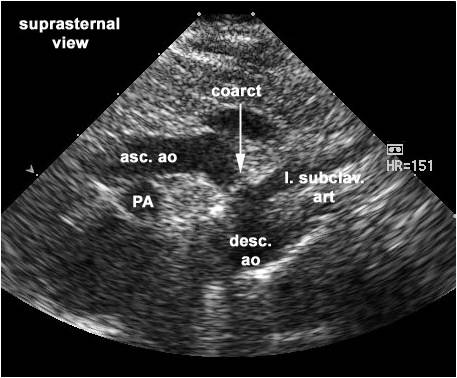Aortic coarctation echocardiography
|
Aortic coarctation Microchapters |
|
Diagnosis |
|---|
|
Treatment |
|
Case Studies |
|
Aortic coarctation echocardiography On the Web |
|
American Roentgen Ray Society Images of Aortic coarctation echocardiography |
|
Risk calculators and risk factors for Aortic coarctation echocardiography |
Editor-In-Chief: C. Michael Gibson, M.S., M.D. [1]; Associate Editor(s)-In-Chief: Priyamvada Singh, M.B.B.S.[2], Cafer Zorkun, M.D., Ph.D. [3]; Assistant Editor(s)-In-Chief: Kristin Feeney, B.S.[4]
Overview
Two dimensional echocardiography allows assessment of the transverse aortic arch, the isthmus, the severity of coarctation, and other associated cardiac abnormalities. Doppler echocardiography helps to decide the gradient across the coarctation and helps in making decisions regarding treatment.
Echocardiography
- 2D echocardiography helps in evaluation of the aortic arch to assess the transverse aortic arch, isthmus, and severity of coarctation.
- Doppler echocardiography helps to decide the gradient across the coarctation and helps in taking decisions regarding treatment.
- Useful in determining associated abnormalities.
- Confirmation by cardiac catheterization is unnecessary. Only done when the diagnosis is unclear, which is rare. It is mandatory in the infant to determine preoperative anatomy.
- Doppler echocardiography is used to measure the gradient at the site of coarctation and to identify the pattern of diastolic runoff typically seen in patients with severe obstruction. Doppler echo may be inaccurate.
Shown below are images of echocardiogram findings of aortic coarctation.
 |

|
Videos
{{#ev:googlevideo|-1958798054061108175&hl=en}}
{{#ev:googlevideo|-5952201527214554387&hl=en}}
2008 ACC/AHA Guidelines for the Management of Adults With Congenital Heart Disease (DO NOT EDIT)[1]
Recommendations for Clinical Evaluation and Follow-Up (DO NOT EDIT)[1]
| Class I |
| "1. Initial imaging and hemodynamic evaluation by TTE, including suprasternal notch acoustic windows, is useful in suspected aortic coarctation. (Level of Evidence: B)" |
References
- ↑ 1.0 1.1 Warnes CA, Williams RG, Bashore TM, Child JS, Connolly HM, Dearani JA; et al. (2008). "ACC/AHA 2008 guidelines for the management of adults with congenital heart disease: a report of the American College of Cardiology/American Heart Association Task Force on Practice Guidelines (Writing Committee to Develop Guidelines on the Management of Adults With Congenital Heart Disease). Developed in Collaboration With the American Society of Echocardiography, Heart Rhythm Society, International Society for Adult Congenital Heart Disease, Society for Cardiovascular Angiography and Interventions, and Society of Thoracic Surgeons". J Am Coll Cardiol. 52 (23): e1–121. doi:10.1016/j.jacc.2008.10.001. PMID 19038677.